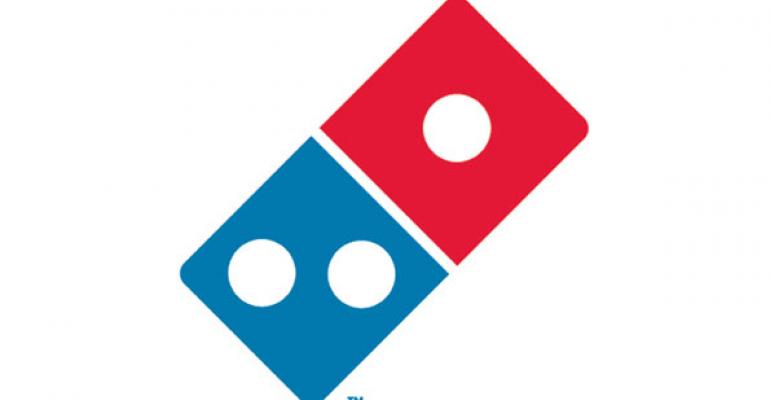Domino’s Pizza Inc. stock hit a new all-time high Thursday after the Ann Arbor, Mich.-based company reported same-store sales growth of nearly 10 percent in the second quarter.
Same-store sales rose 9.7 percent in the U.S. during the second quarter, Domino’s said. On a two-year basis, same-store sales have grown 22.5 percent, an especially strong number in a market that is apparently saturated, and at a time when the industry overall appears to be sluggish.
“There’s no shortage of adjectives we could use to describe our second quarter,” Domino’s CEO Patrick Doyle said during an earnings call Thursday. “Our top-line performance and proven model once again drove remarkable results. The culture of our system is one that faces the challenges of sustained success, head on.”
The company’s stock rose more than 5 percent in Thursday morning trading, hitting a high of $146.73.
Domino’s has been surging for six years now, and same-store sales have increased for 21 straight quarters in the U.S. The company’s stock is up 33 percent year to date.
Internationally, performance has been strong for even longer. Same-store sales rose 7.1 percent outside the U.S., and grew 13.8 percent on a two-year basis. Same-store sales have increased an unheard-of 90 straight quarters in international markets.
This is driving franchisees to build new locations. Over the past 12 months, Domino’s has added more than 1,000 locations worldwide, mostly in international markets. It marks the first time the company has added that many locations in a 12-month period, executives said during the call. Domino’s now has nearly 13,000 units worldwide.
Some of that growth is coming inside the U.S., where the company has added 29 net new locations and 147 units over the past 12 months. Domino’s has 5,245 locations in the U.S., 4,859 of which are operated by franchisees.
That has helped the company generate more revenue, which grew 12 percent in the second quarter, to $547.3 million, from $488.6 million the previous year.
Net income rose 7.3 percent, to $49.3 million, or 98 cents per share, from $45.9 million, or 81 cents per share the previous year.
“I just feel like the overall momentum in the business is very strong,” Doyle said. “Lots of good things happen when you’ve got this much momentum. Franchisees are getting more excited. You see that in the increase in store growth.”
Domino’s said that traffic growth was the reason for its strong domestic same-store sales.
Some of that could be rooted in Domino’s new loyalty program, which the chain introduced last year. The program lets customers easily sign up for the program that gives customers free pizzas after they accumulate a certain number of points.
Customers can easily sign up for the program, and Doyle suggested it is generating traffic, though the company would not say how much.
“Our loyalty program has had a meaningful, positive impact,” he said. “We talked in the first quarter that we were getting good results from loyalty. A quarter later, we’re just that much more confident it is absolutely doing what we thought it was going to do.”
Domino’s has found success in recent years because of its aggressive use of technology. That has continued this year, as the chain added “no click ordering” with an app that will enable customers to simply order a pizza by opening the app and waiting 10 seconds.
“I thought five clicks or less was impressive,” Doyle said.
Coming into the quarter, there were concerns that Domino’s would lose some momentum as Pizza Hut, the country’s largest pizza chain, started generating improved sales and as consumers appear to be pulling back. Same-store sales have been sluggish in recent months, falling or remaining flat based on various restaurant sales indices.
But Doyle quashed suggestions that major pizza concepts simply take business from one another, given the large presence of small chains and independents.
“Given the fragmented market shares within pizza, the individual actions of any player, including us, just don’t have that much effect in the near-term on the other players,” he said.
Major pizza players, with their effective use of technology, continue to take business away from independents, Doyle said.
Another advantage these chains have is value. Pizza concepts have been able to generate business because a single pizza can feed multiple people for a relatively low price.
“It gives us great value on a per-eater basis,” Doyle said. “We have done a much better job overall giving value to consumers. That is clearly why the pizza category has been a little better on overall growth.”
With strong sales come challenges, however, notably labor. Falling unemployment has increased competition for workers. And the influx of delivery companies has also heightened competition for delivery drivers. But the company’s profits give Domino’s an advantage, Doyle said.
“There are markets where labor is tighter than others,” he said. “Clearly, there is a healthy demand for labor out there. But our growth gives us an ability, and our profitability gives us an ability, to compete effectively for these people.”
Contact Jonathan Maze at [email protected]
Follow him on Twitter: @jonathanmaze





